207-780-4249 www.usm.maine.edu/planet
70 Falmouth Street Portland, Maine 04103
43.6667° N 70.2667° W
Altitude: 10 feet below sea level
Founded January 1970
Julian Date: 245963.16
Julian Date: 245963.16
2019-2020: CXXXIII
THE DAILY ASTRONOMER
Friday, April 24, 2020
Remote Planetarium 20: Week 4 Quiz
Remote Planetarium 20: Week 4 Quiz
We've landed! Well, for now. On Fridays we return to the classroom away from the ethereal heights and the mythological community. We have to remain Earthbound today to enjoy the quiz, This 20 question quiz pertains to the topics introduced this week. Five questions from each day. The first five pertain to Monday's class; the second five to Tuesday's, and so forth. Sometimes you will need information from previous weeks, as well. If you would like to see an archive of the past classes as well as the DA's preceding them, go to:
On Monday we'll venture back up into the boundless firmament looming high above the towering summits.
1. Sirius is also known as Alpha Canis Majoris. What can we conclude about Sirius based only on this sentence? (Could be more than one correct answer.)
a. Sirius might be the brightest star in its host constellation
b. Sirius is part of Canis Major
c. Sirius is closer to us than any other star in its constellation
d. Sirius is closer to the Celestial Equator than any other star in its constellation.
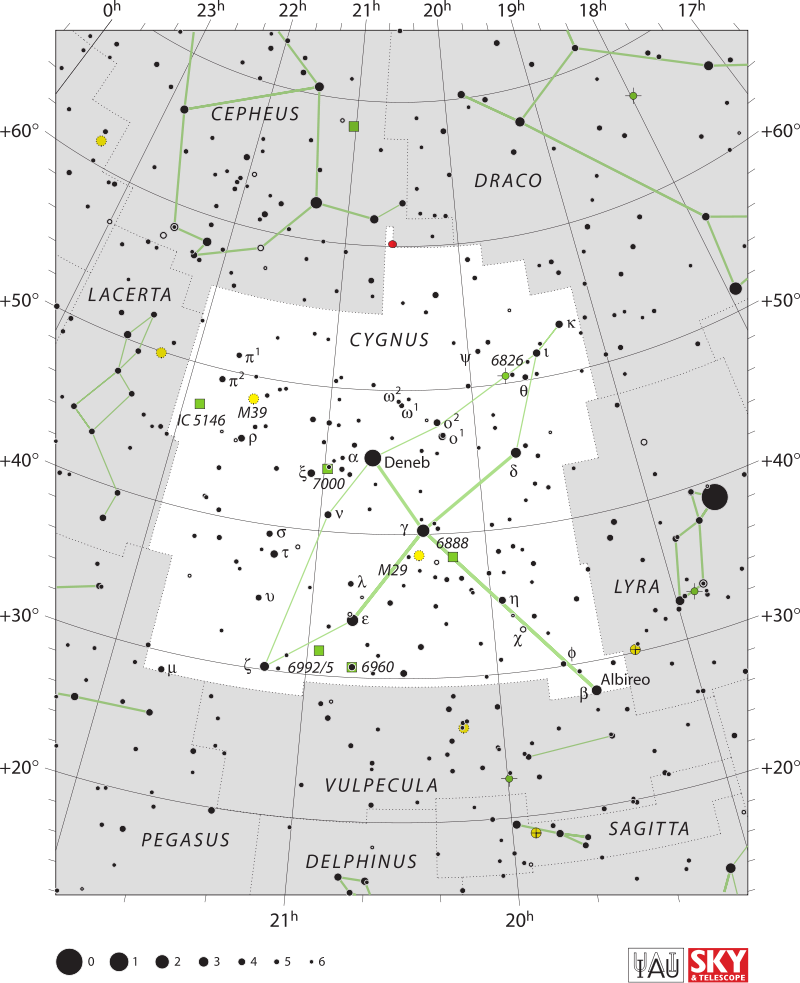
Refer to the image above for questions # 2 and 3
2. How many Messier objects would one find in the Cygnus the Swan region?
a. 0
a. 0
b. 1
c. 2
d. 5
3. Based ONLY on the information contained within the images, what can you conclude about the stars Deneb and Albireo?
a. Deneb is brighter than Albireo
b. Albireo is closer to us than Deneb
c. Deneb remains above the horizon here longer than Albireo
d. Albireo is west of Deneb
4. A star with a magnitude of 0 is how much brighter than a star of magnitude 1?
a. twice as bright
b. 2.5 times as bright
c. four times as bright
d. there is no such thing as a star of magnitude 0
5. What can one conclude about a star with a 8.0 magnitude?
a. it is more than 100 light years away
b. it cannot be seen with the unaided eye
c. intrinsically, it is a very dim star
d. none of the above
6. How many constellations has the International Astronomical Union officially classified?
a. 44
b. 66
c. 77
d. 88
7 _______________________ of the modern constellations derive from those listed in Ptolemy's Almagest
a. All
b. Slightly more than half
c. One quarter
d. Five
8. Why didn't the International Astronomical Union adopt the constellation list Henry Norris Russell developed in the early 1920's?
a. it only contained fifty constellations
b. Russell had been expelled from the IAU the year prior to the list's development due to excessive fighting with other astronomers
c. his list didn't include constellation boundaries
d. because Russell wanted the word "constellations" replaced with "Russellations"
9. We credit the development of the more modern constellations to __________________ different astronomers.
a. one
b. three
c. six
d. ten
10. Name any one of the astronomers who developed some of these modern constellations.
11. The moon will be in what phase during a solar eclipse?
a. full
b. first quarter
c. new
d. last quarter
12. What is the difference between a total solar eclipse and an annular eclipse?
a. an annular eclipse happens every year. A total solar eclipse is far less frequent.
b. during an annular eclipse, the moon doesn't completely cover the Sun, but instead leaves a ring of light around it. The moon completely blocks the Sun during a total solar eclipse
c. a total solar eclipse occurs only in the northern hemisphere. A total solar eclipse occurs in the southern hemisphere.
d. there is no difference.
13. Only those observers residing along the ____________________ will observe a total solar eclipse.
a. totality path
b. annularity path
c. conjunction junction
d. opposition path
14. Eclipses occur within Saros cycles. The April 8, 2024 eclipse is part of Saros Cycle 139. When will the next Saros 139 solar eclipse occur?
a. April 8, 2034
b. April 11, 2040
c. April 20, 2042
d. May 2, 2060
15. Which ONE of the following is not a type of month?
a. synodic
b. anomalistic
c. draconic
d. herculenic
16. What happens during a penumbral lunar eclipse?
a. the moon only moves through the outer part of Earth's shadow
b. the moon moves through only part of Earth's inner shadow
c. the moon moves through the center of Earth's inner shadow
d. none of the above
17. What's the relation between a solar eclipse and a lunar eclipse?
a. a solar eclipse will occur two weeks after a lunar eclipse
b. a lunar eclipse will occur two weeks after a solar eclipse
c. a solar eclipse will occur either two weeks before or two weeks after a lunar eclipse
d. a lunar eclipse will occur the same week as a solar eclipse
18. If a lunar eclipse has a Danjon scale number of 0, what can you conclude?
a. that the moon appeared very bright during totality
b. that the moon appeared quite dark during totality
c. that the moon didn't enter the umbra at all during the eclipse
d. that the moon remained in the umbra for more than two hours
19. Why don't we see lunar eclipses every month?
a. because the moon's orbit is tilted by 5.1 degrees relative to Earth's orbit.
b. because Earth's shadow cone is generally so small it doesn't extend out to the moon
c. we do have lunar eclipses every month. We just don't see most of them
d. none of the above.
20. What does the "gamma" value measure?
a. the minimum distance separating the center of the moon and the center of Earth's shadow
b. the size of the moon during the lunar eclipse
c. the place on Earth where the moon will occupy the zenith at the moment of greatest eclipse
d. the brightness of the moon during totality
ANSWERS
1. Sirius is also known as Alpha Canis Majoris. What can we conclude about Sirius based only on this sentence? (Could be more than one correct answer.)
a. Sirius might be the brightest star in its host constellation
b. Sirius is part of Canis Major
- Well, Sirius is the brightest star in its host constellation. (It is also the brightest star in the night sky.) The Bayer Nomenclature System assigns Greek letters to the stars within a given constellation according to their relative brightness. The brightest star is "alpha," the second brightest "beta," and so on through "omega." However, in 33 of the 88 official constellations, the alpha star is not the brightest. (Example: Orion. Rigel, called Beta Orionis, is the constellation's brightest star, not Betelgeuse.)
- We know that Sirius is part of Canis Major because of the name: Canis Majoris is the Latin genitive (possessive) form of the constellation Canis Major
2. How many Messier objects would one find in the Cygnus the Swan region?
c. 2
Every Messier object is denoted by a capital M followed by a number. Within the area defined as Cygnus the Swan we see M29 and M39. M29 and M39 are both open star clusters. Charles Messier (1730-1817) compiled a list of celestial objects that resembled comets when viewed telescopically. He produced this list for the benefit of other comet-seeking astronomers.
3. Based ONLY on the information contained within the images, what can you conclude about the stars Deneb and Albireo? (Could be more than one correct answer.)
a. Deneb is brighter than Albireo
c. Deneb remains above the horizon here longer than Albireo
d. Albireo is west of Deneb
All four of those statements are correct! (At a distance of 380 light years, Albireo is much closer to us than Deneb, 3200 light years away.) However, one cannot know their relative distances simply by studying this image.
- Deneb is brighter than Albireo. Yes, Deneb is the constellation's alpha star. However, based on what we know about the Bayer Nomenclature System, we cannot be certain that Deneb is the brightest star simply based on this designation. However, the dot representing Deneb is larger than the dots marking the other stars within Cygnus. The legend below the image refers to the magnitudes of the stars. The lower the magnitude (and the brighter the star), the larger the dot used to represent it. The "Deneb dot" is larger than the "Albireo dot." Deneb's magnitude is 1.25; Albireo's magnitude is 3.18.
- Deneb remains above the horizon here longer than Albireo. We can tell that Deneb is north of Albireo because its declination is greater. Deneb's declination is about 45 degrees. Albireo's declination is about 28 degrees. While both stars will be above our horizon for more than twelve hours, Deneb remains in the sky for much longer owing to its higher position.
- Albireo is west of Deneb Albireo's right ascension is about 19 hours 30 minutes. Deneb's right ascension is about 20 hours 41 minutes. As Albireo's right ascension is less than Deneb's, it will be farther to the west.
4. A star with a magnitude of 0 is how much brighter than a star of magnitude 1?
b. 2.5 times as bright
The magnitude system is logarithmic with a factor of 2.5. A difference of 1 magnitude equates to a brightness difference of 2.5x. A star of magnitude 0 is 2.5 times brighter than a star of magnitude 1 and 6.25 times brighter than a star of magnitude 2.
5. What can one conclude about a star with a 8.0 magnitude?
b. it cannot be seen with the unaided eye
Any star with a magnitude of 6 or higher shouldn't be visible to the unaided eye. Some keen-eyed star gazers insist that stars slightly dimmer than mag 6 are visible.
6. How many constellations has the International Astronomical Union officially classified?
d. 88
The International Astronomical Union developed a formal listing of these constellations in 1928 based largely on the work of Belgian astronomer Eugene Joseph Delaporte (1882-1955)
7 _______________________ of the modern constellations derive from those listed in Ptolemy's Almagest.
b. Slightly more than half
They are called "Ptolemy's 48." Forty eight constellations we recognize today were included in Ptolemy's Almagest. Ptolemy's compilation includes the most prominent constellations such as Orion, Peasus, Andromeda, and all the zodiac constellations.
8. Why didn't the International Astronomical Union adopt the constellation list Henry Norris Russell developed in the early 1920's?
c. his list didn't include constellation boundaries
Russell's list was comprehensive and included constellations in both hemispheres. However, it lacked the boundaries the IAU required to completely divide the sky.
9. We credit the development of the more modern constellations to __________________ different astronomers.
b. three
10. Name any one of the astronomers who developed some of these modern constellations.
- Petrus Plancius (1552-1622)
- Johannes Hevelius (1611-1687)
- Nicholas -Louis de Lacaille (1713-1762)
11. The moon will be in what phase during a solar eclipse?
c. new
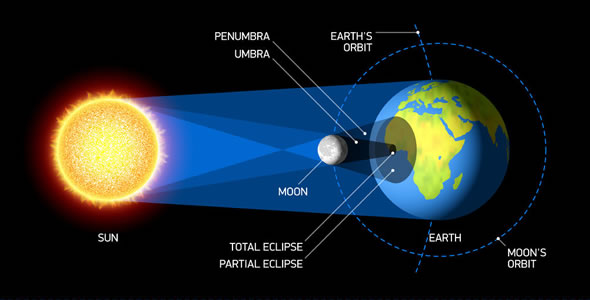
A solar eclipse occurs when the moon appears to move in front of the Sun from our perspective. The only time this sort of eclipse can occur is when the moon is in the new moon phase, when the moon is between the Sun and Earth.
12. What is the difference between a total solar eclipse and an annular eclipse?
b. during an annular eclipse, the moon doesn't completely cover the Sun, but instead leaves a ring of light around it. The moon completely blocks the Sun during a total solar eclipse
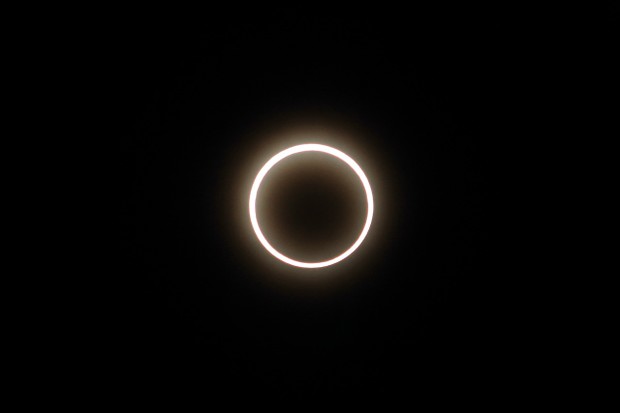
The "ring of fire." The word "annular eclipse" derives from "annulus," meaning ring shaped. Such eclipses occur when the moon is at or near apogee, its greatest distance from Earth. At these times, the moon appears smaller than it does at other points in its orbit.
13. Only those residing along the ____________________ will observe a total solar eclipse.
a. totality path
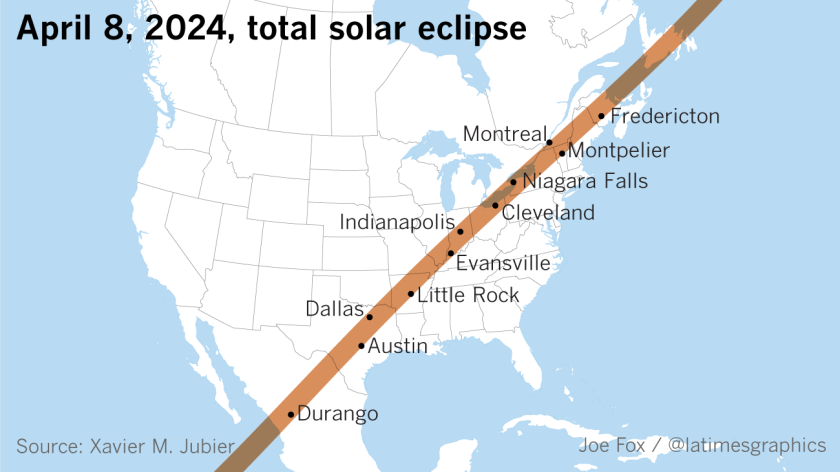
During the April 8, 2024 eclipse, only those observers within the totality path (marked brown in the above image) will see the total solar eclipse. Observers outside this path will see a partial eclipse if they are within a given range of the path or no eclipse at all if they reside outside this range.
14. Eclipses occur within Saros cycles. The April 8, 2024 eclipse is part of Saros Cycle 139. When will the next Saros 139 solar eclipse occur?
c. April 20, 2042
Saros Cycle eclipses occur every 18 years, 11 days and 8 hours apart. We can use this cycle to help us predict when eclipses will occur within a given Saros cycle.
The new few solar eclipses in Saros Cycle 139:
April 30, 2060
May 11, 2078
May 22, 2096
May 11, 2078
May 22, 2096
Saros Cycles are of finite duration. Saros Cycle 139 started on May 17, 1501 and will end on July 3, 2763
15. Which ONE of the following is not a type of month?
d. herculenic
- a synodic month equal to the time period separating successive new moons. Approximately 29.5 days
- a draconic month is equal to the time period the moon requires to return to the same node. Approximately 27.2 days
- an anomalistic month is the time period separating successive perigees. Approximately 27.5 days.
16. What happens during a penumbral lunar eclipse?
a. the moon only moves through the outer part of Earth's shadow
Earth's shadow is divided into two regions: the umbra, the dark inner shadow and the penumbra. During a penumbral eclipse, the moon only moves through the penumbra. One would find it exceedingly difficult to observe any brightness decrease during such an eclipse. The image below shows the moon's path during the three types of lunar eclipse.
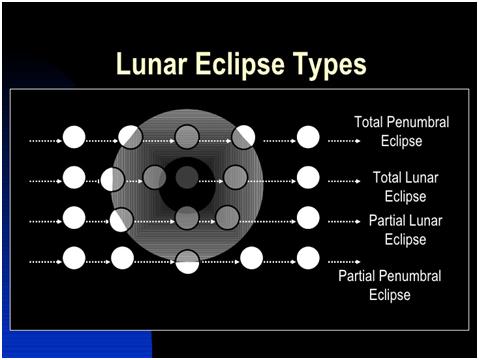
17. What's the relation between a solar eclipse and a lunar eclipse?
c. a solar eclipse will occur either two weeks before or two weeks after a lunar eclipse
Lunar and solar eclipses can only occur when the moon is at or near a node, the intersection point between the two orbits. The moon's orbit contains two nodes separated by 180 degrees. The full moon and new moon positions are also separated by 180 degrees. So, when a solar eclipse occurs, a lunar eclipse will have occurred either two weeks before or two weeks after and vice versa.
18. If a lunar eclipse has a Danjon scale number of 0, what can you conclude?
b. that the moon appeared quite dark during totality
We recall the Danjon Scale
- L = 0 Very dark eclipse. Very dark eclipse. The moon is nearly invisible
- L = 1 Dark grey eclipse; perhaps a ruddy red or brown Moon observable, but its features are vague
- L = 2 Deep red eclipse. Deep red eclipse.The interior of the moon appears a dark red, while the outer regions are brighter outer regions are brighter
- L = 3 Brick- red eclipse. Moon rim brighter and a l Moon rim brighter and a lighter shade of red
- L = 4 Very bright copper Very bright copper-red or orange eclipse. red or orange eclipse. The umbra might even assume a bluish tint. The umbra might even assume a bluish tint. We cannot accurately predict the Danjon rating for the eclipse.
19. Why don't we see lunar eclipses every month?
a. because the moon's orbit is tilted by 5.1 degrees relative to Earth's orbit.

Because the moon's orbit is inclined by 5.1 degrees relative to Earth's orbit, when the moon is full, it will most often pass south or north of Earth's shadow cone.
Only when the full moon moves close to a node (the intersection point between the two orbits) will a lunar eclipse occur.
20. What does the "gamma" value measure?
a. the minimum distance separating the center of the moon and the center of Earth's shadow. This occurs at the moment of greatest eclipse. The value is in terms of Earth radii. If the center of the Moon passed directly through the center of Earth's shadow, Gamma would be zero. The Gamma value is negative because the Moon's center is south of the central shadow point.
To subscribe or unsubscribe from the Daily Astronomer: